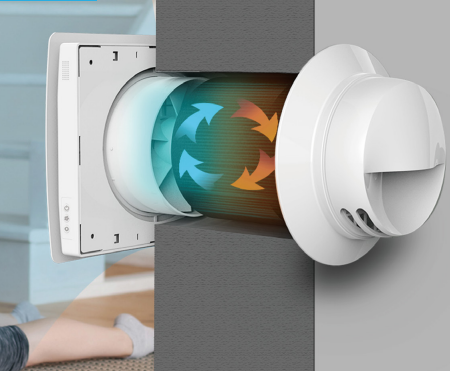The Growing Importance of HRV in Energy-Efficient Home Design
The All-Inclusive Guide to the Uses of Heat Recovery Ventilation in Modern Structures
Heat Recovery Ventilation (HRV) systems represent a substantial improvement in building modern technology (HRV Heat Recovery Ventilation). They supply a method for exchanging stagnant interior air with fresh outside air while minimizing energy loss. This strategy not only boosts indoor air high quality but likewise adds to power efficiency in both household and industrial buildings. Recognizing the different applications and advantages of HRV can expose its vital duty in modern layout and sustainability efforts. The ramifications of this modern technology are worth discovering further
Comprehending Heat Recovery Ventilation Equipments

Lots of modern-day structures prioritize power efficiency, comprehending warmth recuperation air flow (HRV) systems is vital for optimizing indoor air high quality and minimizing energy consumption. HRV systems function by transferring heat from stale interior air to inbound fresh air, properly maintaining comfortable indoor temperatures while reducing energy loss. These systems consist of a heat exchanger, fans, and ductwork that help with the circulation of air. During wintertime, HRV systems capture and reuse heat from the outward bound air, while in summer season, they can aid cool down incoming air. By constantly exchanging air, HRV systems also minimize humidity and the concentration of indoor toxins. Appropriate installation and upkeep of HRV systems are crucial for their performance and efficiency in enhancing total structure efficiency and convenience.
Benefits of Heat Recovery Ventilation
Heat recovery ventilation systems offer countless advantages that improve both energy performance and interior air top quality in modern-day buildings. By capturing and recycling energy from exhaust air, these systems significantly reduce heating & cooling costs, bring about reduced power intake. In addition, they preserve a steady circulation of fresh outside air, minimizing the threat of indoor air contaminants and irritants. This continuous exchange aids regulate moisture degrees, stopping mold and mildew development and making sure a healthier living atmosphere. In addition, HRV systems add to sustainability goals by reducing general carbon impacts. Their capability to optimize ventilation without sacrificing thermal comfort makes them a valuable addition to modern building design, promoting both financial and ecological benefits.
Applications of HRV in Residential Structures
As homeowners progressively focus on power efficiency and interior air high quality, the applications of heat healing ventilation (HRV) systems in household buildings have actually become much more common. HRV systems are especially helpful in tightly sealed homes, where keeping fresh air circulation is vital for protecting against dampness buildup and indoor pollutants. They efficiently transfer heat from outbound stagnant air to inbound fresh air, lowering energy prices connected with heating & cooling. Furthermore, HRVs can improve convenience degrees by managing humidity and temperature. They are likewise adaptable for different property layouts, including single-family homes and multi-unit structures. Overall, incorporating HRV systems supports sustainable living techniques while guaranteeing a healthier interior environment for occupants.
HRV in Commercial and Commercial Setups
In business and commercial settings, the execution of warmth healing air flow (HRV) systems has actually come to be significantly critical for maximizing energy efficiency and maintaining air top quality. These systems properly move heat from exhaust air to inbound fresh air, link minimizing the requirement for additional home heating or air conditioning. This not only decreases power costs but additionally adds to sustainability campaigns. Industries such as manufacturing, warehousing, and office buildings benefit greatly from HRV systems, as they assist manage temperature and moisture levels, making certain a comfy and productive atmosphere. HRV systems aid in getting rid of pollutants and excess dampness, enhancing indoor air quality. As laws around air top quality become more stringent, the adoption of HRV technology is most likely to grow, making it an important component of modern-day industrial and industrial infrastructure.
Future Trends in Heat Recovery Ventilation Technology

Frequently Asked Concerns
How Does Heat Recovery Ventilation Impact Indoor Air Top Quality?
Heat recovery ventilation significantly enhances interior air top quality by constantly exchanging stale indoor air with fresh exterior air while recuperating power. This process decreases pollutants, keeps official website suitable moisture degrees, and guarantees a much healthier atmosphere for passengers.
Can HRV Solutions Be Set Up in Existing Buildings?
HRV systems can certainly be mounted in existing structures. Retrofitting find more info may require alterations to ductwork and ventilation layouts, however it significantly improves energy efficiency and interior air quality, making it a feasible option for older structures.
What Upkeep Is Needed for HRV Solutions?

Are There Specific Climates Where HRV Is More Efficient?
Heat recovery ventilation systems are specifically efficient in climates with substantial temperature distinctions between periods. These systems enhance power efficiency by recuperating heat from exhaust air, making them optimal for both cool and moderately warm atmospheres.
Exactly How Do HRV Solutions Affect Energy Costs?
